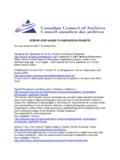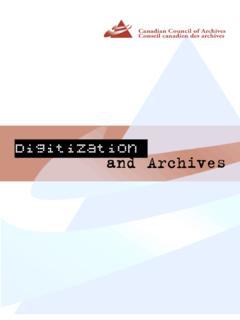Transcription of GENERAL RULES FOR DESCRIPTION
1 Revised version july 2008 1-1 CHAPTER 1 GENERAL RULES FOR DESCRIPTION Contents GENERAL RULES Preliminary rule Scope Multilevel DESCRIPTION Sources of information Form of presentation Organization of the DESCRIPTION Punctuation Levels of detail in the DESCRIPTION Language and script of the DESCRIPTION Inaccuracies Accents and other diacritical marks TITLE AND STATEMENT OF RESPONSIBILITY AREA Preliminary rule Title proper GENERAL material designation Parallel titles Other title information Statements of responsibility EDITION AREA Preliminary rule Edition statement Statements of responsibility relating to the edition GENERAL RULES Revised version july 2008 1-2 CLASS OF MATERIAL SPECIFIC
2 DETAILS AREA Preliminary rule DATE(S) OF CREATION, INCLUDING PUBLICATION, DISTRIBUTION, ETC., AREA Preliminary rule Date(s) of creation Place of publication, distribution, etc. Name of publisher, distributor, etc. Statement of function of publisher, distributor, etc. Date of publication, distribution, etc. Place of manufacture, name of manufacturer, date of manufacture PHYSICAL DESCRIPTION AREA Preliminary rule Extent of descriptive unit (including specific material designation)
3 Other physical details Dimensions Accompanying material PUBLISHER'S SERIES AREA Preliminary rule Title proper of publisher's series Parallel titles of publisher's series Other title information of publisher's series Statement of responsibility relating to publisher's series Numbering within publisher's series ARCHIVAL DESCRIPTION AREA Preliminary rule Administrative history/Biographical sketch Custodial history Scope and content GENERAL RULES Revised version july 2008 1-3 NOTE AREA Preliminary rule Notes STANDARD NUMBER AREA Preliminary rule Standard number GENERAL RULES Revised version july 2008 1-4 GENERAL RULES Preliminary rule Scope.
4 These RULES may be used to describe fonds, series, collections, and discrete items. Where the DESCRIPTION of a fonds, series, or collection as a whole constitutes the highest level of DESCRIPTION , the descriptions of its parts constitute lower levels of DESCRIPTION . Using these RULES , archival materials are represented by a set of descriptions which show the unit as a dynamic whole, consisting of lower-level parts that may include series, files, and items. Each of these parts becomes (or has the potential to become) an object of DESCRIPTION , resulting in multiple descriptions that need to be linked hierarchically to represent the part-to-whole Institutions also acquire discrete items that do not form part of a larger body of materials ( , a fonds).
5 These RULES also provide guidance for the consistent DESCRIPTION of and access to discrete items, alongside other holdings. For the DESCRIPTION of discrete items, refer to the RULES contained in Chapter 13. For the level of detail required at different levels of DESCRIPTION see Multilevel DESCRIPTION . Use multilevel DESCRIPTION for preparing descriptions of archival material whose arrangement is characterized by multiple aggregations, and when, in addition to the highest level of DESCRIPTION , separate descriptions of some or all of its parts are required.
6 The following RULES apply when establishing a hierarchy of descriptions . DESCRIPTION from the GENERAL to the specific. At the highest level of DESCRIPTION , give information for the fonds, series or collection as a whole. At the next and subsequent levels, give information for the parts being described. Present the resulting descriptions in a hierarchical part-to-whole relationship proceeding from the highest level to the more specific. 1 The RULES in this chapter do not prescribe the number of levels to be described in a multilevel DESCRIPTION .
7 The decision to describe to a certain level is an institutional one that will vary from one unit of material to the next, depending on the nature, size, and importance of the various component parts. Nor do the RULES require that, at a given level of DESCRIPTION ( , at the file level), all the records at that level ( , all of the file) be described. GENERAL RULES Revised version july 2008 1-5 Information relevant to the level of DESCRIPTION . Provide only such information that is appropriate to the level being described.
8 For example, do not provide detailed file content information if the unit being described is a fonds; do not provide an Administrative history for an entire department if the creator of a unit being described is a division or a branch. Linking of descriptions . Link each DESCRIPTION to its next higher unit of DESCRIPTION , if applicable, and identify the level of DESCRIPTION in the Scope and content (see ). Non-repetition of information. At the highest appropriate level, give information that is common to the component parts.
9 Do not repeat information at a lower level of DESCRIPTION that has already been given at a higher level, unless specifically instructed to do so in the following RULES , or unless essential for Sources of information. Each chapter in Part I contains a specification of the chief source of information for each level of DESCRIPTION at which the material is being described within the broad class of material covered by that chapter. For each area of the DESCRIPTION one or more sources of information are prescribed. Enclose in square brackets information taken from outside the prescribed source(s) unless otherwise instructed in specific RULES .
10 For an aggregate level of DESCRIPTION ( , for a fonds, series, file) the chief source of information will be collective in nature. For an item, the chief source of information may be collective or may be unitary in nature. An example of a chief source of information that is unitary in nature is the chief source for a textual item which is the title page. Prefer information found in that chief source to information found elsewhere. When the sources of information are placed in a ranking order, follow that order. Form of presentation.




